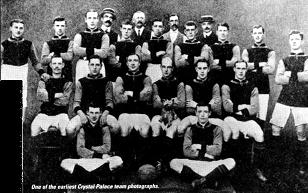Crystal Palace Football Club 100 Years Old
The club is producing a DVD and book to mark this milestone and Croydon Council is hosting a centenary exhibition in the Clocktower. Any Palace fan will know that the club has experienced many highs and lows and we all have our own personal memories that will always be there to cherish.
1905 may have been the start of the club but the story began some time before this as we take you back to the 1800s.
There had been clubs calling themselves Crystal Palace since 1861 but the arrival of the FA Cup Finals and England Internationals to the football ground at The Crystal Palace from 1895 - and the huge crowds they drew — made The Crystal Palace Company realise that a football team playing there regularly could be sustained by sufficient support.
A first approach to the Football Association in 1904 on this subject was declined as the FA did not like the idea of the owners of the Cup Final ground possessing its own football club.
Thus The Crystal Palace Company went about organising an independent club to bear the Crystal Palace name. Chairman J. H. Cozens, and his predecessor Henry Gillman, consulted Aston Villa Football Club and, in particular. William McGregor who had been the founding father of the Football League. Mr McGregor fully endorsed the idea, stating in December 1904: "believe a really good team at The Crystal Palace would be a tremendous draw."
Aston Villa also offered the services of one of their assistant secretaries, Edmund Goodman, for the task of setting up this new club. Following his arrival in south London, Goodman was soon busy, first of all approaching Sydney Bourne, whom he noted was a great supporter of the Cup Finals, to be a director and, at the same time, finding five more like minded gentlemen.
At the club's first meeting Bourne was elected chairman and the position of secretary was offered to Goodman.An agreement dated 29th April 1905 was entered into by which the football club acquired the use of the football ground from The Crystal Palace Company on Sydenham Hill for five years on very favourable terms. A prospectus for the club was issued in May 1905 which stated: "It is the general opinion of followers of football that a first-class professional football club for the south of London has long been wanted and we, the directors, concede that the time has arrived when an effort should be made to promote a first-class team."
The club was formed with a nominal capital of £5,000 in £1 shares, of which 3,281 were taken up During the summer, John Robson, from Middlesbrough, was appointed manager and players were brought in as the club applied to join the Football League. It failed by one vote. By the time this decision was known it was too late to apply for entry to the Southern League Division One and the club had to finally settle for a place in the Second Division, facing, in the main, the reserve teams of those in the First Division. To supplement these fixtures the club also entered the United Counties League in which most games were played midweek.
So it was that the club's first game was played in this lesser league, away at New Brompton (now Gillingham) on 1st September 1905, while the first game at The Crystal Palace in the Southern League Division Two was against Southampton Reserves on the following day.
Since 1905 the club has moved grounds twice and has played in every division of the football league, including a number of periods in the top flight, most recently last season 2004.
The season-long exhibition being held at the Croydon Clocktower will showcase the history of the club Admission will be free and will give visitors the chance to see numerous pictures, artefacts and memories from the past 100 years. In addition, the club is producing an educational CD-Rom that will be distributed to primary schools across the borough, which, as well as encouraging schoolchildren to attend the exhibition, uses the history of the club to help teach regular curricular activities.
David Hudson, communications and corporate affairs director of sponsor Nestle said. "Nestle" UK is delighted to support the Crystal Palace Centenary Exhibition and the supporting educational materials which will be used by primary school children throughout the borough. Nestle is committed to supporting the borough and its residents. Many of our employees have been life-long supporters of the club and this is a unique opportunity to show our support of Crystal Palace FC and its role in the Croydon community."
